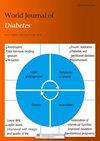GCKR 基因 rs780094 多态性与伴有白蛋白尿的 2 型糖尿病之间的关系
IF 4.2
3区 医学
Q1 ENDOCRINOLOGY & METABOLISM
引用次数: 0
摘要
背景 糖尿病肾病是 2 型糖尿病(T2D)的常见并发症之一。早期没有典型症状,当白蛋白尿达到较高水平时,病情将发展到中晚期。治疗困难,预后不良。目前,糖尿病肾病的发病机制尚不清楚,认为与遗传和环境因素有关。目的 探讨葡萄糖激酶调节蛋白(GCKR)基因 rs780094 多态性与伴有白蛋白尿的 T2D 之间的关系。方法 选取我院 2020 年 1 月至 2020 年 10 月收治的 252 例 T2D 患者(男 126 例,女 126 例)和 66 例健康人群(女 44 例,男 22 例)。根据尿白蛋白/肌酐比值,受试者被分为 I 组(对照组)、II 组(正常白蛋白尿的 T2D 患者)、III 组(微量白蛋白尿的 T2D 患者)和 IV 组(大量白蛋白尿的 T2D 患者)。此外,根据受试者是否出现白蛋白尿,将其分为 M 组(正常组)或 N 组(白蛋白尿组)。我们检测了所有受试者的 GCKR 基因 rs780094 多态性(C/T),并测定了 GCKR 基因 rs780094 多态性(C/T)与白蛋白尿 T2D 的相关性。结果 I-IV组的基因分布和基因型分布符合Hardy-Weinberg平衡。四组之间的基因型频率存在明显差异(P = 0.048,χ 2 = 7.906)。白蛋白尿 T2D 风险因素的逻辑回归分析表明,CT + TT 基因型(几率比 = 1.710,95% 置信区间:1.172-2.493)是一个风险因素。结论 CT + TT 基因型是白蛋白尿 T2D 的风险因素。今后,我们可以对携带易感基因的个体进行风险评估,以延缓 T2D 的发病。本文章由计算机程序翻译,如有差异,请以英文原文为准。
Relationship between GCKR gene rs780094 polymorphism and type 2 diabetes with albuminuria
BACKGROUND
Diabetic kidney disease is one of the common complications of type 2 diabetes (T2D). There are no typical symptoms in the early stage, and the disease will progress to moderate and late stage when albuminuria reaches a high level. Treatment is difficult and the prognosis is poor. At present, the pathogenesis of diabetic kidney disease is still unclear, and it is believed that it is associated with genetic and environmental factors.
AIM
To explore the relationship between the glucokinase regulatory protein (GCKR ) gene rs780094 polymorphism and T2D with albuminuria.
METHODS
We selected 252 patients (126 males and 126 females) with T2D admitted to our hospital from January 2020 to October 2020, and 66 healthy people (44 females and 22 males). According to the urinary albumin/creatinine ratio, the subjects were divided into group I (control), group II (T2D with normoalbuminuria), group III (T2D with microalbuminuria), and group IV (T2D with macroalbuminuria). Additionly, the subjects were divided into group M (normal group) or group N (albuminuria group) according to whether they developed albuminuria. We detected the GCKR gene rs780094 polymorphism (C/T) of all subjects, and measured the correlation between GCKR gene rs780094 polymorphism (C/T) and T2D with albuminuria.
RESULTS
Gene distribution and genotype distribution among groups I-IV accorded with the Hardy-Weinberg equilibrium. Genotype frequency was significantly different among the four groups (P = 0.048, χ 2 = 7.906). T allele frequency in groups II, III, and IV was significantly higher than that in group I. Logistic regression analysis of the risk factors for T2D with albuminuria showed that the CT + TT genotype (odds ratio = 1.710, 95% confidence interval: 1.172-2.493) was a risk factor.
CONCLUSION
CT + TT genotype is a risk factor for T2D with albuminuria. In the future, we can assess the risk of individuals carrying susceptible genes to delay the onset of T2D.
求助全文
通过发布文献求助,成功后即可免费获取论文全文。
去求助
来源期刊

World Journal of Diabetes
ENDOCRINOLOGY & METABOLISM-
自引率
2.40%
发文量
909
期刊介绍:
The WJD is a high-quality, peer reviewed, open-access journal. The primary task of WJD is to rapidly publish high-quality original articles, reviews, editorials, and case reports in the field of diabetes. In order to promote productive academic communication, the peer review process for the WJD is transparent; to this end, all published manuscripts are accompanied by the anonymized reviewers’ comments as well as the authors’ responses. The primary aims of the WJD are to improve diagnostic, therapeutic and preventive modalities and the skills of clinicians and to guide clinical practice in diabetes. Scope: Diabetes Complications, Experimental Diabetes Mellitus, Type 1 Diabetes Mellitus, Type 2 Diabetes Mellitus, Diabetes, Gestational, Diabetic Angiopathies, Diabetic Cardiomyopathies, Diabetic Coma, Diabetic Ketoacidosis, Diabetic Nephropathies, Diabetic Neuropathies, Donohue Syndrome, Fetal Macrosomia, and Prediabetic State.
 求助内容:
求助内容: 应助结果提醒方式:
应助结果提醒方式:


